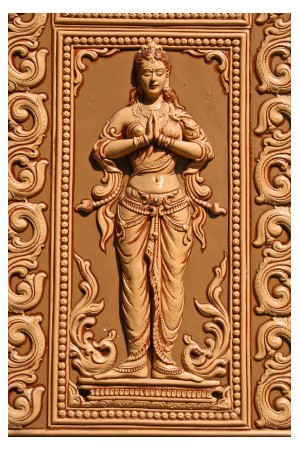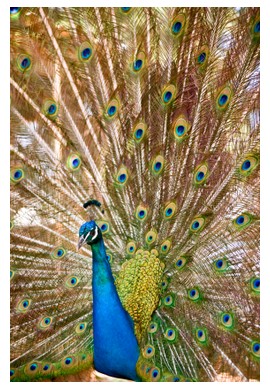A Backpacker's Guide to
India Culture
- The Social Etiquette in India
Quick links:
Indian culture will blow you away.
Modern India is a home to over a billion people, and it's one of the world's largest ethnic melting pots. The culture of India is a result of influences from immigrants fleeing to the country for the last centuries.
Apart from alien smells and the delicious Indian food, there's a lot more to this country. Numerous ethnic groups mean different Indian cultures, and also different appearances and way of living. When you travel around India from north to south, there's no doubt that you'll notice the vast contrasts!
Like, the Sikhs are taller than the Indians, the gypsy-like Aryan people in the northern part of the country have blue eyes, compared to the brown-eyed South Indians and so on.
All of this together emphasizes one thing: India has a colorful diversity.
First, some essential information you must know about when it comes to Indian Culture:
- Type of government: Republic
- Religion: The official religion in India is Hinduism; about 80% of the Indian population is Hindus. And the second largest religion is Islam. Sikhism is also a large religion in the country.
- National Animal: Tiger
To understand the India culture, you need to understand the Indian religion.
Here I've focused on Hinduism:
- Important religious, Hindu expressions: Dharma (duties), moksa (liberation from the material world), samsara (rebirth), karma (right action),guru (teacher), sadhu (holy man)
- Hindu religious life in India takes the form of meditation, family duties and devotion to the Gods
- The purpose of life is to obtain moksa from reincarnation
- The Hindus believe that if their karma is not resolved, they're soul is born into a new body (reincarnation)
- Hinduism encourages among other things; truth, nonviolence, contentment, cleanliness, contentment, and prayers
- One of the Hindu ways of life is to live in harmony with the environment, and not exploit the nature.
Hierarchy
Indians are conscious about social order because of the influence from the caste system. This applies in all relations; family, friends, colleagues, and even strangers.
India Culture:
Meeting the locals

- Indians greet each other by joining their palms together (like if you're praying), and then saying: Namaste. If you're a male traveler and meet an Indian woman, be careful with how you meet her. It's not socially accepted for an Indian woman to touch other men (besides their husband and sons). So what you have to do is to wait for her to take the initiative to do the handshake.
- The lack of privacy is one of things that characterizes the Indian social culture. There's no such thing as: Can I have my privacy?
- Other things that you'll notice when meeting the locals is
1) the staring and
2) the personal questions
They stare at you like if you were an alien, but they normally do this because they're curious. Some will even start taking pictures of you, like you were the attraction.
How to handle the staring?
I tried to stare back once, but it didn't work. It felt awkward to look into a stranger's eyes for too long, so I dropped out of the staring contest. Ignore it, and do something else until you can't sense their staring anymore. It's India.
How about handling the personal questions? Adjust! Play along, and smile! ;-)
- Don't step over people
The older and more respected they are, the more important this is.
- Time doesn't matter in India. Patience is a virtue in India.
Things take time; delayed trains and buses, long queues, the food you ordered takes time, and so on.
Example: We took the bus from Jaipur to Delhi (2007), and we had chosen a bus that would correspond with the flight to Bangkok.
The bus was supposed to leave at 10 pm, but it didn't leave until 11.15 pm. The bus driver kept saying '10 minutes, 10 minutes'. Those minutes became much longer, it was so stressful.
Indian Men vs. Foreign Women
As a ground rule in the culture of India, Indian men are brought up to keep their distance with women, hence respect them. But how come there are stories about Indian men harassing foreign women?
Well, the ground rule has apparently exceptions. Why they do it, can be a lot of things, like if you're improperly dressed. But even women travelers wearing respectable clothing can be victims of sexual harassment. The question is:
How do you handle it?
If it's possible, move away as far as possible. If that's not possible, make a fuss. Some Indian men don't (or don't want to) understand the word "no," so make a scene if there's no other option (yell or scream). They'll be so embarrassed that they have to leave you alone.
Click to read more about backpacking safety for female travelers in India.
India Culture:
Eating with the locals
It's common to eat with your right hand,
for instance you should use your hands when eating thali meals like this one
- Don't eat with your left hand
It's considered dirty because that's the hand they're using when washing themselves after toilet business.
- Eating beef is considered as taboo by Hindus
- Spice it up!
Most Indians like their food spiced up, and I mean really spiced up with especially masala spices. In South India, I witnessed several locals adding spices to their water... yeah, I know!
And they also added masala to their fruit salad. Their taste buds are so accustomed to spicy food that they literally have to add spices to everything.
- Eat all the food you have on your plate
This is considered as respect for the food that has been served.
- India is the largest producer of tea......and tea drinking is an essential in an Indian's everyday life. You will find chai (tea) all over India, wherever you are. Have a cup and enjoy ;-)
Visiting a local's home
When invited to a local's home, you'll feel like an honored guest. The Indians are known to be warm and give great hospitality.
- Take off your shoes/sandals before entering the home
- It's not mandatory to bring a gift when visiting a local's home
Visiting Sights and Attractions

- Dress appropriately
Make sure that the shorts or skirt is below the knee, and avoid showing off too much flesh.
For female travelers, the best thing would be to wear traditional clothing like 'churidar'. More and more travelers do this and has a good effect on the way locals perceive you. You should wear the shawl that comes with the churidar.
The locals said to me: 'without the shawl, you're not really wearing a churidar'.
- Behave
It might sound obvious to you, but it's easy to forget. Avoid loud laughter and conversation. And most importantly, don't criticize the religion. If you have to, do it in your head or after the visit.

- Follow the rules assigned for the visitors for that particular temple
- When visiting Hindu temples, don't point your feet at a holy object, like a sculpture of a God
- It's forbidden for females who are menstruating to enter a Hindu temple because they're considered unclean. Nowadays, it's becoming more 'normal' for Indian women who are menstruating to enter a temple. Not everyone follows it.
India Culture:
Public Affection
Physical contact between the sexes is considered as provocative behavior, and will usually cause a negative effect in large parts of India.
What so weird though, is the common sight of two men holding hands together in public, walking down the streets like they were a couple. You will often see this in the big cities.
Return to top of India Culture
India Culture:
Important animals in India

Why are there cows almost everywhere you go in India?
In Hinduism, cows are a symbol of life and considered as a source of food. So it can't be killed, and hence they're just left alone.
Indian Peacock
The Indian Peacock is the national bird of India, and is a symbol of pride, beauty and royalty.
It's considered as sacred in India.
You'll notice them when visiting great palace sites, either engraved in the wall or alive in a beautiful garden.
Look for India Culture Shock! (book) through Amazon.com or other books on Indian culture. Culture Shock! is a great book on culture of India!
|
Further reading: |
Like this page?
|
Return to top of India Culture
Follow This Site
Search this site
Most popular articles
» Travel Forum: Itineraries
» Travel Insurance
» Nightlife in Kuala Lumpur
» Route Planner
» Packing List
» Life After Backpacking
» Kuala Lumpur Malaysia
» Perhentians Malaysia
» Review of massage in Kerala
» Review of Erawan waterfalls/
Train Travel in India
About Cleartrip booking system
Connect with us
Books on Indian Culture:















Comment this page:
Have your say about what you just read! Leave me a comment in the box below.